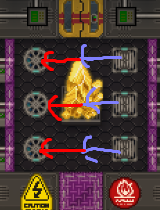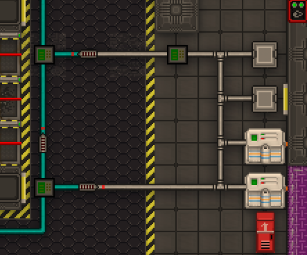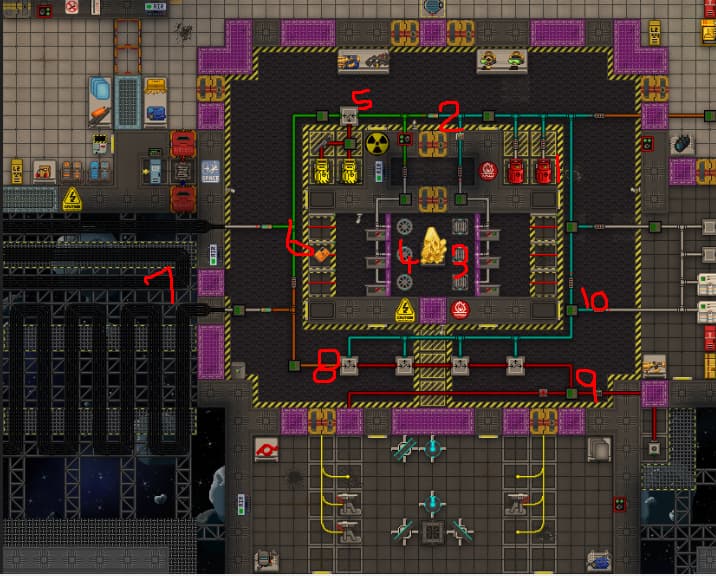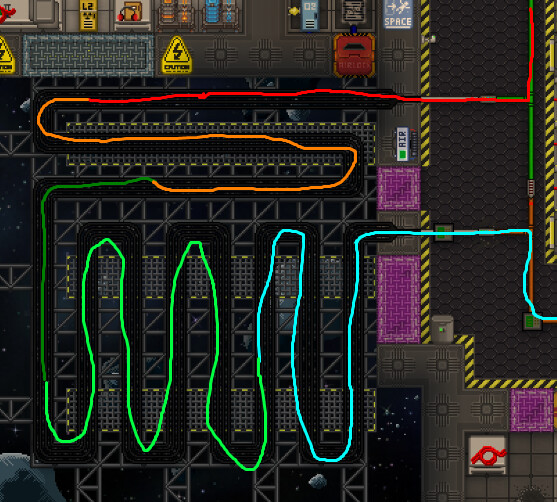This is not a guide on how to set up the supermatter, but on how it works
While it may help you learn how to set up the supermatter, this guide is not based around that
Lets start step by step on how the gas loops, starting from the canister till the end of the loop
1. How Gas enters the loop

here you see the gasses entering the chamber, the legend is
RED: Canisters
GREEN: Recycled
BLUE: Atmos Piped
- Canister gases come from, well where you expect it, the canisters you wrench in, this is your main way of entering gases to the engine
- Recycled gases are gases that have went trough the filter (8.) and have not been spaced, these are the gases you put into the SM going back for round 2
- Atmos Piped gases are gases that atmos techs have piped directly into the supermatter, these are rarely used unless a setup that constantly removes gas (such as CO2 SM) is used
2. How gas enters the chamber

Gas enters from the right, exits from the left
The top is the bypass, this is only used if gas cannot be shoved into the SM fast enough such as during a plasmafire
3. and 4., scrubbers and vents

When powered the supermatter constantly makes:
- Heat
- Oxygen
- And plasma
due to this you need to constantly add a gas and remove the gases inside, this is where the previous parts come in and start adding a cooled down gas of your choice, normally N2
The gasses are then sucked out via the scrubbers
5. The filter

This is a part most new players forget about, this removes a certain gas from the loop and adds it to a wrench in canister, it is almost always useless unless a CO2 setup is done and there it is used to bottle up pluoxium, some people add a layer adapter before and after it so gases can continue flowing freely without needing to remove it
6. Gas to cooling and 7. The cooling loop
its a simple step, you turn on the pump and have space magically cool your gases, this is sometimes turned off if tier 4 coolers are installed for more optimal cooling
8. and 9.Recycling Filter

its quite simple, you simply choose which gases you want to keep on the recycler (normally the gases you wrenched in with the canisters) and they’ll be brought back into the loop, otherwise they’ll be spaced
10. The freezers

similar to the space loop but with electric freezers rather than the coldness of space
!!THESE ARE USELESS FOR NORMAL OPERATION UNLESS THEY ARE UPGRADED TO TIER 4 PARTS DUE TO SPACE BEING COLDER!!
some people use this as to also plug in gases pre-cooled but not that many do it as its normally non-essential
after this it goes all the way back to 1.
I made the end part of this guide in a bit of a rush so I’ll probably polish it later, otherwise if you have any feedback you can yell at me down below
TODO
- Add how the supermatter makes gases
- Add how the supermatter makes radiation
- Add how emitters work
- Add how pressure, heat and charge effects the supermatter

